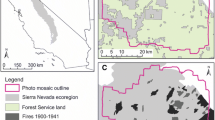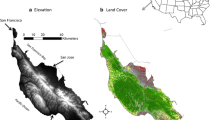Abstract
Landsat TM scenes for 1985 and 1991 are used to produce a georeferenced map of land cover and land use for an area of the Amazon estuary inhabited by three populations of caboclos with distinct patterns of land use. This information is combined in a geographic information system with ethnographic and survey research carried out over the past 5 years to develop representative spectral “signatures” which permit measurement and differentiation of land uses and the detection of change even between small areas of managed floodplain forest and unmanaged forest, and between three distinct age/growth classes of secondary succession following deforestation. Implementation of these procedures permit the scaling up or down of research at different resolutions. Three distinct patterns of land use are examined with differential impact on the environment. Mechanized agriculture at one site has eliminated virtually all the mature upland forest and is now dominated by secondary successional vegetation. The more traditional system of diversified land use at the next site shows a subtle cycling of flooded forest to managed palm forest through time in response to the price of palm fruit and cycling in the use of fallow land. A third site, based on palm fruit extractivism, shows minimal changes in land cover due to persistent specialization on management of flooded forest extraction. There is little evidence that the community with the greatest impact on forest cover is any better off economically than the two communities which have minimal impact on the landscape. This study suggests how a balance between use and conservation in Amazonia may be achieved in floodplain and estuarine areas, and the effectiveness of monitoring these types of land cover from satellite platforms.
Similar content being viewed by others
References
Anderson, A. B. (1991). Forest management strategies by rural inhabitants in the Amazon estuary. In Gómez-Pompa, A., Whitmore, T. C., and Hadley, M.Rainforest Regeneration and Management, Man and the Biosphere Series (Vol. 6), UNESCO and the Parthenon Publishing Group, Paris.
Anderson, A. B., Gely, A., Strudwick, J., Sobel, G. L., and Pinto, M. G. C. (1985). Um sistema agroforestal na vazea do estuário AmazÔnico (Ilha das OnÇas, Municipio de Barcarena, Estado do Pará),Acta Amazonica 15: 195–224.
Behrens, C. A. (1990). Applications of satellite image processing to the analysis of Amazonian cultural ecology. Conference proceedings,Applications of Space Age Technology in Anthropology, John C. Stennis Space Center.
Brondizio, E., and Neves, W. (1992). A percepÇāo do ambiente natural por parte de populaÇóes caboclas do Estuario do Amazonas: uma experiencia piloto atraves do método de trilhas prefixadas. Paper presented on the symposiumUma estrategia Latino Americana para Amazonia, MarÇo 1992, Sāo Paulo.
Brondizio, E., Moran, E., Mausel, P. and Wu, Y. (1993). Dinámica na VegetaÇāo do Baixo Amazonas: Análise Temporal do Uso da Terra integrando Imagens Landsat TM, levantamentos floristico e Etnográfico.Anais do VII Simposio Brasileiro de Sensoriamento Remoto. Curitiba, Paraná, Brazil, May 10–14, 1993.
Chibnick, M. (1994).Risky Rivers. University of Arizona Press, Tucson.
Conant, F. (1990). 1990 and beyond: Satellite remote sensing and ecological anthropology. In Moran, Emilio (ed.),The Ecosystem Approach in Anthropology. From Concept to Practice. The University of Michigan Press, Ann Arbor.
ERDAS 7.5 (1991).Field Guide Manual. ERDAS, Atlanta, Georgia.
FIBGE (1984). Base Cartografica 1∶100.000, Folha Ponta de Pedras.
Hiraoka, M. (1985). Mestizo subsistence in Riparian Amazonia.National Geographic Research 1: 236–246.
Lima, R. (1956). Agricultural nas várzeas do Estuario de Amazonas.Boletim Técnico de Instituto Agronomico do Norte. 33: 1–164.
Moran, E. (1974). The adaptive system of the Amazon Caboclo. In Wagley, Charles (ed.),Man in the Amazon. University of Florida Press, Gainesville.
Moran, E. (1981). Developing the Amazon. Bloomington Indiana University Press.
Moran, E. (1990). Ecosystem ecology in biology and anthropology: A critical assessment. In Moran, Emilio (ed.),The Ecosystem Approach in Anthropology. From Concept to Practice. The University of Michigan Press, Ann Arbor, pp. 3–40.
Moran, E. (1993a). Deforestation and Land use in the Brazilian Amazon.Human Ecology 21: 1–21.
Moran, E. (1993b).Through Amazonian Eyes: The Human Ecology of Amazonian Populations. University of Iowa Press, Iowa City.
Moran, E., Brondizio, E., Mausel, P., and Wu, Y. (1994). Deforestation in Amazonian: Land use change from ground and satellite level perspectives.BioScience 44(5): 329–338.
Morren, G. E. B. (1990). New technology and regional studies in human ecology: A Papua New Guinea example. Conference proceedings,Applications of Space-Age Technology in Anthropology, John C. Stennis Space Center.
Murrieta, R., Brondizio, E., Siqueira, A., and Moran, E. (1989). Estrategias de subsistencia de uma populacao riberinha da ilha do Marajo.Boletim do Museu Paraense Emilio Goledi, serie Antropologia 5: 147–163.
Murrieta, R., Brondizio, E., Siqueira, A., and Moran, E. (in press). Estrategias de subsistencia da comunidade de Praia Grande, Ilha do Marajo.Boletim do Museu Paraense Emilio Goeldi, serie Antropologia.
NASA (1990). Conference proceedings,Applications of Space-Age Technology in Anthropology, John Stennis Space Center.
Naveh, Z., and Lieberman, A. L. (1984).Landscape Ecology: Theory and Application. Springer-Verlag, New York.
Parker, E. (1985). The Amazon Caboclo: An introduction and overview. InThe Amazon Caboclo: Historical and Contemporary Perspectives. Studies in Third World Societies, College of William and Mary, Williamsburgh, Virginia.
Prance, G. (1980). A terminología dos tipos de florestas amazÔnicas sujeitas à inundaÇoes.Acta AmazÔnica 10: 495–504.
RADAM (1974).Radar da Amazonia. Departamento Nacional de Minas e Energia, DNPM.
Reining, P. (1980).Challenging Desertification in West Africa: Insights from Landsat into Carrying Capacity, Cultivation, and Settlement Sites in Upper Volta and Niger. Center for International Studies, Ohio University, Athens.
Vink, A. P. A. (1980).Landscape Ecology and Land Use. Longman, New York.
Wagley, C. (1953).Amazon Town. Macmillan, New York.
Author information
Authors and Affiliations
Rights and permissions
About this article
Cite this article
Brondizio, E.S., Moran, E.F., Mausel, P. et al. Land use change in the Amazon estuary: Patterns of caboclo settlement and landscape management. Hum Ecol 22, 249–278 (1994). https://doi.org/10.1007/BF02168853
Issue Date:
DOI: https://doi.org/10.1007/BF02168853




